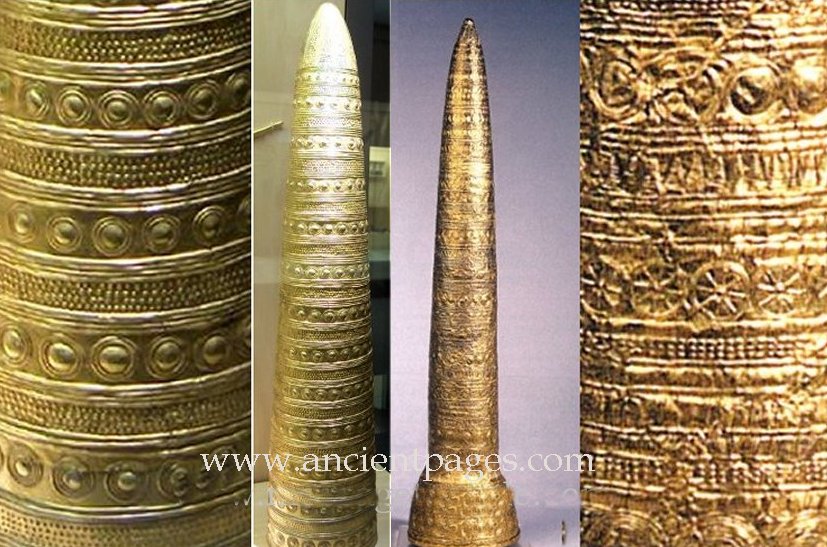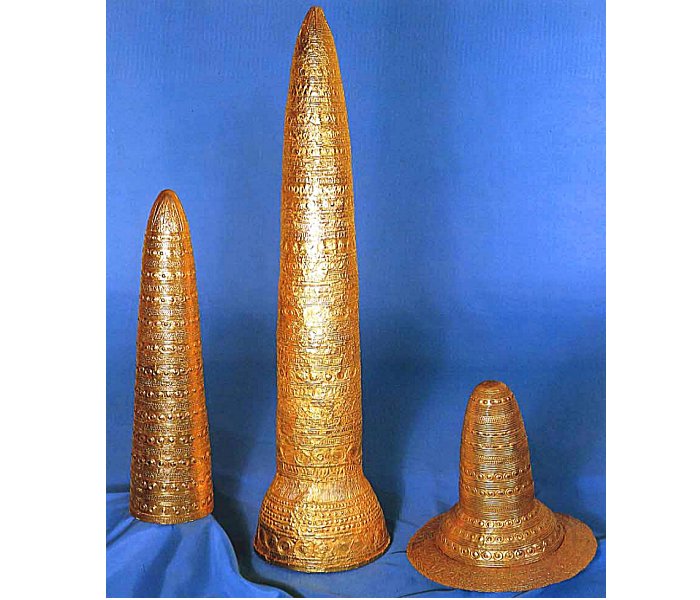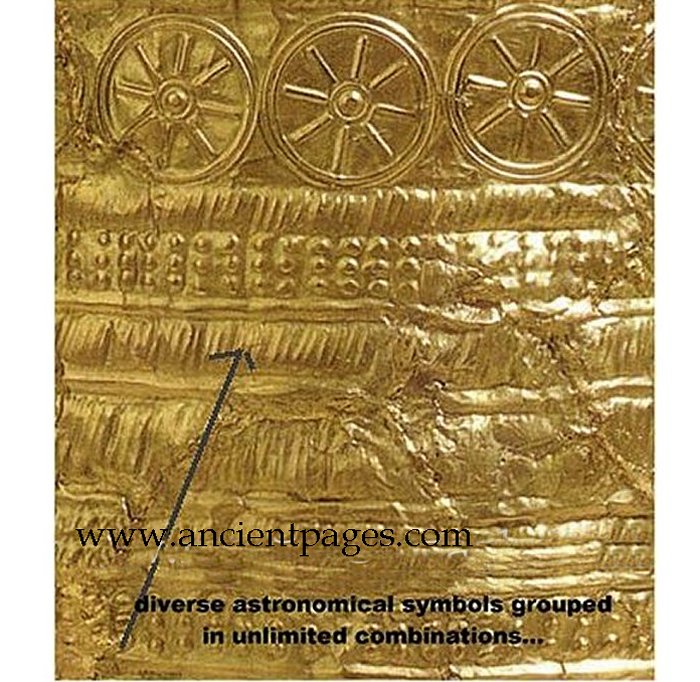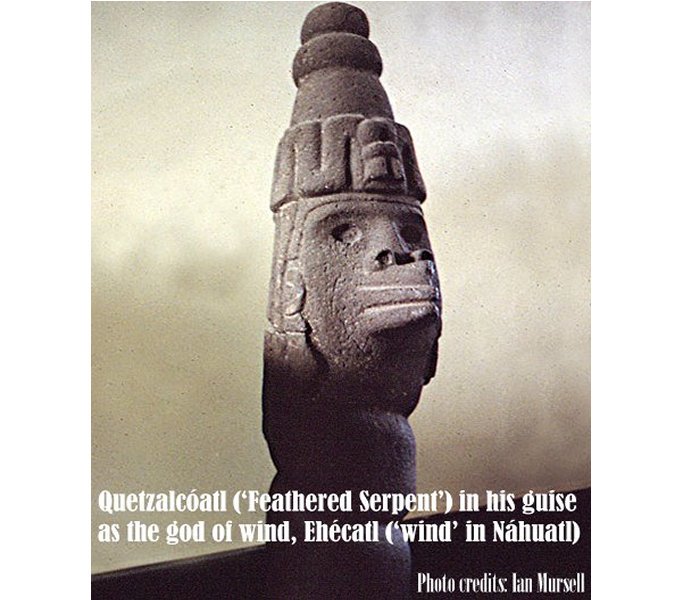Mystery Of 3,000-Year-Old Conical Hats – Was It A Highly Advanced Device?
A. Sutherland - AncientPages.com - They are considered to be "hats of ancient wizards" but their original purpose has baffled scientists for many decades.
Did wizards wear conical hats? Similar hats were worn by many gods. Quetzalcoatl wore his conical cap as Ehecatl, the snake-bird deity, and god of wind feared by the Aztecs, the Sumerian gods were often depicted in similar cone-shaped hats.
Are the circular symbols on the golden hats a proof of a highly advanced astronomical knowledge of the Bronze Age or perhaps the hats were used as cult objects in ceremonies and rituals?
If so, who was the subject of this worship?
Could the Bronze Age people possess such sophisticated astronomical skills as those presented on conical hats? Where did their advanced knowledge come from?
At first, there was only "a piece of sheet metal 8 cm below the surface of the earth. Since this disturbed the work, it was chopped up and thrown away carelessly. It was only when the sheet metal pieces were washed away by the rain that they were recognized as gold and collected by a worker's wife. Georg Raschke, then head of the prehistoric and early history collection of the Germanisches Nationalmuseum, was able to correctly classify the fragments based on the circular ornaments on them. He managed to buy the gold sheets (280 g) and when the site was examined, he found further fragments (30 g) and fragments of two bronze tires. Subsequently, it turned out that these could have been part of a hat brim reinforcement." 1
Four of the elaborately decorated cones have been uncovered at sites in Switzerland, Germany, and France over the past 170 years.
The first of them is 'Golden Hat of Schifferstadt', discovered in 1835 at Schifferstadt near Speyer, c. 1400–1300 BC; the second is the so-called 'Avanton Gold Cone' (incomplete), found at Avanton near Poitiers in 1844, and dated to c. 1000–900 BC.
The third one of these artifacts known as 'Golden Cone of Ezelsdorf-Buch', also dates back to c. 1000–900 BC and was discovered near Ezelsdorf near Nuremberg in 1953. It is the tallest known 'hat' measuring about 90 cm. The fourth is 'Berlin Gold Hat', probably originates from Swabia or Switzerland, and is dated to c. 1000–800 BC.
The gold hats are 3,000 years old and are very similar to each other regarding their form and symbolism and decoration like disks, circles, and wheel symbols.
All four hats were hammered up whole from a single piece of gold.
One of the theories proposes that mysterious conical hats were worn by "king-priests" (Lords of Time) possessing supernatural powers because of their ability to predict the correct time to sow, plant and harvest.
The tallest of them, measuring 90 cm, is that found in Ezelsdorf near Nürnberg. Germany in 1953.
According to scientists who analyzed strange artifacts, these were used to calculate the movements of the sun and the moon in advance.
Another opinion is that the cone-shaped ceremonial hats represent the conical crown of the gods from the region of the Near East, which should serve 'the cultic 'exaggeration' of a person through a high head covering.' The mysterious conical hats have been also related to the so-called 'priest-kings' (Lords of Time) who possessed supernatural powers because of their ability to predict the correct time to sow, plant, and harvest.
However, there are other interpretations of numerous combinations of both astronomical and calendrical symbols that cover four conical hats.
Mysterious hats are composed of 10 to 20 zones filled with a different number of symbols. The number of circles of each symbol and the number of symbols from one or more zones is multiplied in a first step, the total amount means a number of days.
Then the number of days is compared to astronomical cycles like the synodic month or the tropical year.
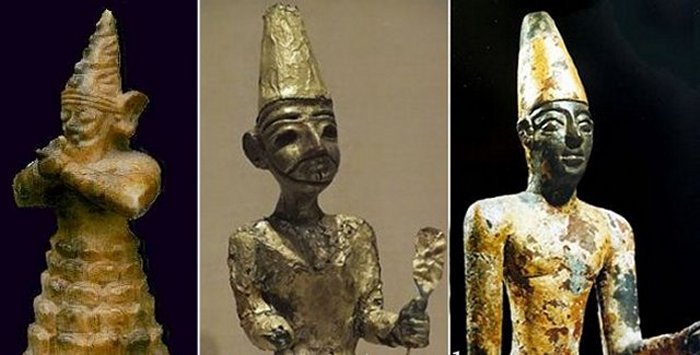
Left: Hittite figure of Baal: Canaanite God El - Megiddo, Modern Israel, c.1400 BC; Right: Phoenician deity Reshep, Byblos, 19th-18 century B
Other explanations suggest hats, quivers, calendars of a different kind, containers, crowns, and much more.
According to scientific studies, the 1,739 sun and half-moon symbols decorating the hat's surface make up a scientific, still undeciphered code which resembles 18.67-year cycle called the "Metonic Cycle" probably identified by Meton of Athens (born circa 460 B.C.; date of death unknown), a Greek mathematician, astronomer, geometer, and engineer.
But the problem is that the Meton's "discovery" took place 500 years after the mysterious conical hats were made.
Similar five golden cones were also unearthed in Ireland during the 17th and 18th centuries and even in many other places of prehistoric Europe, according to Prof Sabine Gerloff, a German archaeologist from Erlangen University, Germany and other researchers.
Written by – A. Sutherland AncientPages.com Staff Writer
Copyright © AncientPages.com All rights reserved. This material may not be published, broadcast, rewritten or redistributed in whole or part without the express written permission of AncientPages.com
Expand for referencesReferences:
D. Price, Europe Before Rome: A Site-by-Site Tour of the Stone, Bronze, and Iron Ages
More From Ancient Pages
-
 On This Day In History: Edict Of Longjumeau Was Signed And Ended Second War of Religion – On Mar 23, 1568
News | Mar 23, 2017
On This Day In History: Edict Of Longjumeau Was Signed And Ended Second War of Religion – On Mar 23, 1568
News | Mar 23, 2017 -
 Ancient DNA Helps Reveal Social Changes In Africa 50,000 Years Ago That Shaped The Human Story
DNA | Jun 7, 2022
Ancient DNA Helps Reveal Social Changes In Africa 50,000 Years Ago That Shaped The Human Story
DNA | Jun 7, 2022 -
 Unique Sword Discovered In Mysterious Pre-Viking Tomb In Uppsala, Sweden
Archaeology | Sep 2, 2019
Unique Sword Discovered In Mysterious Pre-Viking Tomb In Uppsala, Sweden
Archaeology | Sep 2, 2019 -
 On This Day In History: Admiral Richard E. Byrd Made His First Flight Over The South Pole – On Nov 29, 1929
News | Nov 29, 2016
On This Day In History: Admiral Richard E. Byrd Made His First Flight Over The South Pole – On Nov 29, 1929
News | Nov 29, 2016 -
 The City Of David – Why Is It So Controversial?
Biblical Mysteries | Jan 9, 2019
The City Of David – Why Is It So Controversial?
Biblical Mysteries | Jan 9, 2019 -
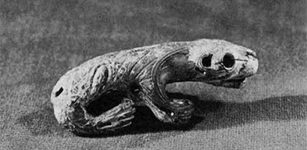 Ancient City Of Ipiutak Was Built By A Fair-Haired Race With Blue Eyes And Not Us – The Inuit Say
Featured Stories | Apr 23, 2019
Ancient City Of Ipiutak Was Built By A Fair-Haired Race With Blue Eyes And Not Us – The Inuit Say
Featured Stories | Apr 23, 2019 -
 Los Millares – 5,000-Year-Old Advanced Copper City In Europe
Featured Stories | Mar 24, 2016
Los Millares – 5,000-Year-Old Advanced Copper City In Europe
Featured Stories | Mar 24, 2016 -
 Mysterious Nine Worlds Of Yggdrasil – The Sacred Tree Of Life In Norse Mythology
Featured Stories | Mar 8, 2017
Mysterious Nine Worlds Of Yggdrasil – The Sacred Tree Of Life In Norse Mythology
Featured Stories | Mar 8, 2017 -
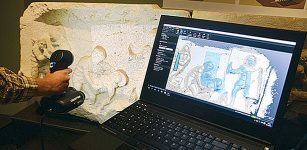 Archaeologists Use Laser Technology To Create Digital Models Of Ancient Artifacts
Archaeology | Jan 28, 2016
Archaeologists Use Laser Technology To Create Digital Models Of Ancient Artifacts
Archaeology | Jan 28, 2016 -
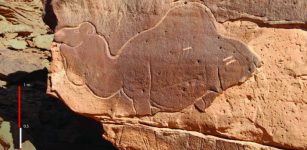 Huge Ancient Animal Sculptures Made By Unknown Carvers At Camel Site In Saudi Arabia Puzzle Archaeologists
Archaeology | Feb 14, 2018
Huge Ancient Animal Sculptures Made By Unknown Carvers At Camel Site In Saudi Arabia Puzzle Archaeologists
Archaeology | Feb 14, 2018 -
 Late Roman-Era Rooms, Offering Vessels Unearthed At Ancient City Of Antiocheia, Southern Türkiye
Archaeology | Oct 31, 2022
Late Roman-Era Rooms, Offering Vessels Unearthed At Ancient City Of Antiocheia, Southern Türkiye
Archaeology | Oct 31, 2022 -
 Mystery Of Count St. Germain – He Claimed To Have Lived For Several Centuries
Featured Stories | Sep 4, 2014
Mystery Of Count St. Germain – He Claimed To Have Lived For Several Centuries
Featured Stories | Sep 4, 2014 -
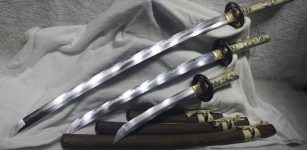 Samurai Swords: Katana And Wakizashi And Their Long Tradition
Ancient Traditions And Customs | Aug 6, 2018
Samurai Swords: Katana And Wakizashi And Their Long Tradition
Ancient Traditions And Customs | Aug 6, 2018 -
 Nazar Amulet – Blue Color Wards Off The Evil Eye According To Ancient Belief
Ancient Symbols | Mar 13, 2018
Nazar Amulet – Blue Color Wards Off The Evil Eye According To Ancient Belief
Ancient Symbols | Mar 13, 2018 -
 Vast Network Of Previously Unknown European Bronze Age Megastructures Discovered
Archaeology | Nov 20, 2023
Vast Network Of Previously Unknown European Bronze Age Megastructures Discovered
Archaeology | Nov 20, 2023 -
 Jebel Sahaba: Analysis of 13,000-Years-Old Bones Reveals Prehistoric Violent Raids But Not A Single Armed Conflict
Archaeology | May 27, 2021
Jebel Sahaba: Analysis of 13,000-Years-Old Bones Reveals Prehistoric Violent Raids But Not A Single Armed Conflict
Archaeology | May 27, 2021 -
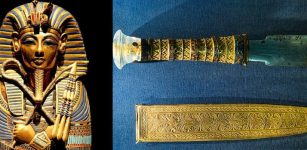 Tutankhamun Had An Ancient Dagger From Outer Space
Archaeology | Jun 1, 2016
Tutankhamun Had An Ancient Dagger From Outer Space
Archaeology | Jun 1, 2016 -
 Sanctuary Of God Mithra And His Mysterious Religion Unearthed In Corsica
Archaeology | Mar 2, 2017
Sanctuary Of God Mithra And His Mysterious Religion Unearthed In Corsica
Archaeology | Mar 2, 2017 -
 Dead City Of Serjilla – Byzantine Village In Syria Struggling To Survive The Middle Of A War Zone
Featured Stories | Jan 27, 2020
Dead City Of Serjilla – Byzantine Village In Syria Struggling To Survive The Middle Of A War Zone
Featured Stories | Jan 27, 2020 -
 Illuminati: Facts And History About The Secret Society
Featured Stories | Mar 30, 2017
Illuminati: Facts And History About The Secret Society
Featured Stories | Mar 30, 2017

